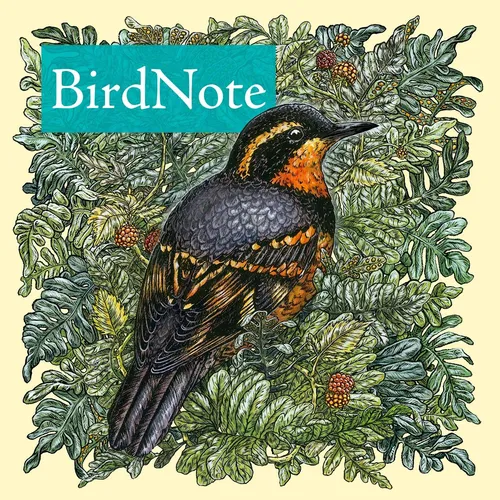
BirdNote Daily
Escape the daily grind and immerse yourself in the natural world. Rich in imagery, sound, and information, BirdNote inspires you to notice the world around you.
- Update frequency
- every day
- Average duration
- 1 minutes
- Episodes
- 1173
- Years Active
- 2022 - 2025

Spring Migration Across the Globe
Each spring, millions of birds head north. From Ecuador, beautiful Scarlet Tanagers fly to the eastern US and Canada, many traversing the Gulf of Mexico, an arduous journey. Across much of southern E…

Great-tailed Grackle
Great-tailed Grackles live up to their name. The glossy black males trail their long, V-shaped tails behind them as they fly, almost like a plane towing a banner ad. And while not quite as flashy, th…

Brewer’s Sparrow, Sagelands Singer
One of the most musical and complex bird songs in the US is that of the Brewer's Sparrow. It's a veritable aria, ringing forth from the sagebrush of Eastern Washington's Columbia Basin. Shrub-steppe …

Recycle Your Eggshells to Help Nesting Birds
Female birds need to eat calcium to have enough of the mineral to lay their eggs. But it can be hard to find enough of it to eat in nature. We can help our backyard birds by offering them some extra …

The Eagle Eye
Ever heard the term “eagle eye”? An eagle’s vision is incredibly sharp, and its eyes can weigh more than its brain. The secret to the bird’s exceptional vision is the density of visual cells – the ro…

Magpies Help Each Other Remove Tracking Devices
Tracking birds can be tricky — even with GPS technology. Around 70% of bird species are just too small to carry a GPS battery. But recently, Australian scientists developed GPS trackers that looked l…

Stefania Gomez - Swifts
Each September, thousands of Vaux's Swifts roost in the chimney of Chapman Elementary School in Portland, Oregon, a stopover on their southern migration. Crowds gather every night to watch the specta…

A Kettle of Vultures
In the daytime, hot air rises as the sun heats the ground. The rising column of air is called a thermal, and it’s the perfect way for a Turkey Vulture to hitch a ride. Like an elevator to the skies, …

The Ruby-crowned Kinglet Tunes Up
The Ruby-crowned Kinglet is one of the smallest songbirds on the continent, weighing in at just a little more than half a chickadee. Mostly green and hard to spot, it hovers in mid-air as it catches …

Nest Building
Want to try building a nest? Consider this... An average American Robin weighs less than three ounces. An average person weighs 170 pounds, or 1,000 times as much as a robin. A robin's nest, made of …

Cuckoos - Tent Caterpillar Birds
One of two species of cuckoos in North America, the Yellow-billed Cuckoo, pictured here, lives in broadleaf forests throughout the East and riparian stands in the Southwest. They were common breeding…

From Bobwhite Coveys to Pairs
Throughout winter, Northern Bobwhites gather in groups called ‘coveys’ to search for food during the day and share warmth at night. These small quail arrange themselves in a circle, with their tails …

Monk Parakeets
If you live in the U.S., parrots might seem like ambassadors from far-off rainforests. Especially since the Carolina Parakeet, a native species once common in the South and Midwest, went extinct in t…

Camille T. Dungy on Nature and Motherhood
Writer Camille T. Dungy’s book Trophic Cascade deals with themes of nature and becoming a mother. The title is an ecological term, referring to the far-reaching changes on an ecosystem caused by the …

Rapid Evolution in the Galápagos Islands
Scientists have long thought that new species took a very long time to emerge. This thinking has now changed dramatically. On an island in the Galápagos, researchers Rosemary and Peter Grant discover…

Kari Sasportas on Advocating for Autistic Birders
For Kari Sasportas, who helps lead the Feminist Bird Club of Boston, birding is a way to become absorbed in the sensations of the outside world — something that can be difficult for them to do elsew…

White-crowned Sparrow
The White-crowned Sparrow pours out its song over and over on spring and summer days-and even on moonlit nights-often up to 15 times a minute. Now here's a curious thing: Just as people in different …

Spring Rain Refreshes a Desert
Springtime in the Anza-Borrego Desert State Park in southeastern California. Cacti and wildflowers glisten with raindrops, and birds begin to sing. A House Finch, a Bewick's Wren, a Cactus Wren, a Mo…

Have You Ever Seen a Tom Turkey's Beard?
With his brilliantly colored plumage fanned out in display, this tom (male) Wild Turkey is a handsome sight to behold. He has a bright red head, long spurs, and… a beard. This “beard” is a small clus…

A Natural Feast for Hummingbirds
Hoping to attract hummingbirds to your yard or balcony? One way is to grow native plants. Native plants provide cover, and they offer nectar in spring and summer. They also attract insects, the most …